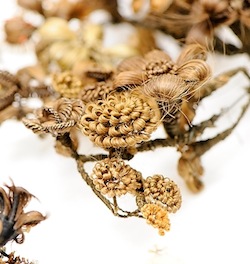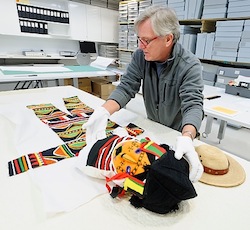Large, culturally significant textile collection unpacked
Rehousing assistant David Wells unpacks hair wreaths from the Victorian era. From 1850 to 1875, hair wreaths were a popular way to pay tribute to a loved one. Numerous people would donate hair in order to create one. While not worn, hair wreathes would be proudly displayed in glass cases as decorative objects.
Photos: Bryce Richter
Some days, it’s an Egyptian pounded metal shawl. Other days , it’s a 17th century kimono.

“The detail is just amazing,” Wells says. “In many cases, this is women’s domestic work that goes unsung.”
Yes, all kinds of works of art are being unpacked as part of the more than 13,000-piece Helen Louise Allen Textile Collection. The collection had been housed off campus for four years while work was being completed on the new Nancy Nicholas Hall in the School of Human Ecology Building. Starting in August 2012, the collection has come back home to its new climate-controlled space specifically designed to preserve the pieces from one of the largest textile collections in the United States.
Helen Louise Allen was a professor at the University of Wisconsin–Madison from 1927 until her death in 1968. Allen was an expert in the history of textiles, interiors, and in weaving and embroidery techniques. She was a pioneer in her field, using historical and anthropological perspectives in the study of textiles.

Wells unpacks a child’s costume from Nigeria. Archival tissue is put into it so the fabric can lie flat and won’t crease or wrinkle.
Allen had a strong interest in ethnographic textiles, building up a private textile collection to support her teaching and research.
She had accumulated about 6,000 pieces and thousands more have been added. More than 9,000 pieces can be seen online.
But the collection is meant to be seen up close – with gloves of course. After it’s all unpacked, people can request to see the objects.
“We can now provide accessibility to the collection that we never had before,” Rehousing Assistant David Wells says. “It’s a great home for it.”
The goal of the collection is to further the understanding of human beings within their material and social environments through the study of textiles of artistic, cultural and historic significance.
Wells stores the costume in a shelving unit. The shelves are dust and light proof with the entire area climate controlled. It is kept at 50 percent humidity and 60 degrees – ideal storage temperatures although volunteers are advised to wear polar fleece to keep warm.
Tags: arts, history, School of Human Ecology




